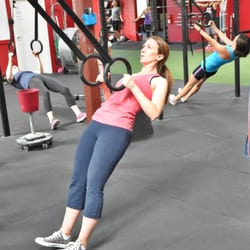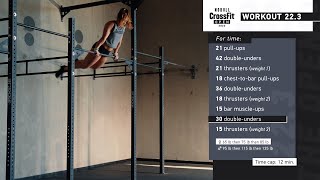
Are you searching for a CrossFit position? You're not the only one looking for a CrossFit job. CrossFit is an emerging lifestyle that combines functional movements with high intensity and constant variability. Developed by Greg Glassman and Lauren Jenai, the CrossFit methodology is a registered trademark. Continue reading to find out more about this rewarding career. The best thing? You can even work remotely! Here are some top benefits of working as a CrossFit Coach.
Position description
Crossfit job descriptions are a great way to get a job in the industry. This section of a job description is meant to outline the general nature of a position, not to list all of its details. It's not crucial to determine the order in which duties and responsibilities should be performed. More information on the job description of Crossfit trainer can be found here. For more details, read on.
Salary
Salaries at CrossFit gyms vary greatly, with the lowest paying job earning $0 per year. The most lucrative positions in CrossFit are those of Head Trainer or Owner/Operator. Both earn more than six figures. Other high-paying jobs at CrossFit include Program Director and Senior Training Specialist. Volunteers make an average of over twenty thousand dollars a year. Continue reading to learn more about the average salary for CrossFit jobs.
Benefits
You can work in a healthy workplace. Modern living is stressful. People sit for hours at a desk, truck, or office, and even the most active people can suffer from sedentary jobs. While being a trainer may not be as difficult as working in an office, you will find yourself among like-minded people. A career in fitness can help you maintain a balance between work and home, as well as the opportunity to sport workout gear around your house.

Conditions for working
A fitness trainer must lift and carry heavy objects, walk, climb and kneel. They need to be able coordinate their hands and feet and have good vision to help members. They also must be able to communicate effectively with other employees and citizens. The work environment they are exposed to includes noise, dust, chemicals and water. This article will discuss some important considerations when applying for a job as a fitness trainer.
FAQ
What is the best exercise routine to build muscle?
There are two major exercises that you should do when you want to build muscle mass. These are isolation exercises and compound moves. While isolation exercises focus on specific muscles, compound moves target multiple muscle groups simultaneously.
It is important to do exercises that work all of your major muscles groups. This ensures you're always pushing yourself during your workouts.
MyFitnessPal, an app that tracks your actions, can be used to help you keep track. You can log everything, from calories burned to weight lifting. It also allows you to create meal plans customized for your goals.
Is it true to say that protein overeating can lead to kidney stones?
Protein helps maintain healthy bones and tissue. Over-consuming protein can result in calcium being excreted through the kidneys. This can cause kidney stones.
It is important to keep in mind that not everyone will develop kidney stones if they consume more protein than 2 grams per kilogram (2.2lbs). You don't have to eat a lot of protein to get kidney stones.
You can prevent kidney stones by watching your sodium consumption. Sodium regulates the body's water balance. Too much sodium can lead to kidney stones.
You can also reduce your intake of proteins if you develop kidney stones. For most people, protein provides half their daily caloric requirements. If you cut back on protein, you'll likely lose weight.
If you do decide to eat more protein, don't go overboard. Aim for less than 20% of total calories from protein.
Is Cardio Better Than Strength Training?
Both are equally great. Cardio is better if you are looking to build muscle faster.
Cardio burns more calories per hour than strength training, and also burns more fat.
Strength training builds muscle mass, but it takes longer to achieve this goal than cardio.
How quickly can I transform my body?
Change your mindset is the first step. You must first decide to change.
After you have made the decision to change, you should commit to working towards your fitness goals for at minimum 3 months.
You will then need to choose a program that is compatible with your lifestyle.
Also, you need to set realistic goals. Don't spend your hard earned money on a gym membership if you don't have the motivation to work hard.
Instead, make use of your time outdoors.
Spend an hour walking around the block every day and you will burn enough calories to lose 1 lb each week.
Once you have a plan, you can start to organize your life according to this plan.
It is important to set aside time every day for exercise before going to work. You can also take breaks throughout each day to get up and move.
Finally, you should reward yourself when you reach milestones. You can buy accessories and clothes that reflect your success.
How many calories do I need to eat each day?
The exact amount varies depending on the person. An average person needs 2000-2500 calories per day. The factors that determine how many calories are needed for you include your gender, age, height, activity level, lifestyle, and gender.
Statistics
- By John Thompson Take a whopping 38% off a set of PowerBlock Pros. (menshealth.com)
- 10 pounds in a month is likely during a lean bulking phase, especially for beginners. (muscleandstrength.com)
- Candidates and applicants must pass all four tests at 70% (minimum level) to graduate from Basic Deputy U.S. Marshal (BDUSM) Training. (usmarshals.gov)
- An estimated calorie range for moderately active adult males falls between 2,200 to 2,800 calories per day, depending on age. (eatright.org)
- Get free shipping and 25% off today. (healthline.com)
External Links
How To
How do I lose weight while working out?
Exercise burns calories through increased metabolism and oxygen consumption.
If you exercise with moderate intensity, you can safely lose weight.
To burn fat while exercising, follow these tips:
-
Cardio exercises include swimming, running or cycling.
-
Exercise for 30 minutes three times per week.
-
You can lose weight by adding strength training to the routine.
-
Avoid doing intense exercises. It's possible to build muscle, but not lose it.
-
When exercising, make sure to drink lots of water. Water helps flush out toxins and keep your body properly hydrated.
-
Choose low-fat protein shakes after working out. Protein shakes help repair muscles and boosts energy.
-
So you don’t feel hungry, eat smaller meals throughout your day.
-
Don't skip breakfast! Skipping breakfast can lead to fatigue and sluggishness.
-
Mental health is important. Stressful situations may slow down your metabolism.
-
Keep a positive attitude. Research shows that overweight people gain more weight if they believe they are overweight than those who believe they look good.
-
Get enough sleep. Insufficient sleep can make it more difficult to lose weight.
-
Keep active. Get up every hour and get moving.
-
Maintain a healthy diet. A healthy diet will help you feel fuller for longer.
-
Relaxation is possible by finding ways to relax. An anxious mind won't allow your body release stress hormones, which can lead to the destruction of muscle tissue.
A balanced diet is one that includes all of the essential nutrients required for growth.
Eat six small meals each day instead of three large ones. This gives your body time and energy to process the food.
For strong bones to be maintained, you need approximately 500mg of calcium per day. Calcium can also be found in milk products, yogurt, fortified Soy beverages, orange Juice, cereals and bread.
Calcium can be found in leafy green veggies, beans, tofu and nuts as well as seeds, nuts and cheese.
Vitamin D is essential for calcium absorption. Vitamin D can be found in egg yolk, fatty fish, and other fortified foods.
Vitamin E is vital for your skin's health. Vitamin E is found in vegetable oils and wheat germ oil, as well as peanuts, almonds and sunflower seeds.
Your body needs zinc to maintain normal immune function and heal wounds. Zinc can be found in seafood, legumes and meats.
Zinc deficiency can cause fatigue and loss of appetite. It can also lead to depression and impaired immunity.
Insulin resistance is caused by eating too much sugar, which can increase blood glucose levels. Insulin resistance can lead to weight gain.
Insulin resistance is caused by high blood levels of free-radicals. Free radicals are molecules with unpaired electrons that damage cell membranes and other parts of the body.
Free radicals come mainly from food additives, pesticides, herbicides, preservatives, smoking, air pollution, radiation, chemicals in cosmetics, lotions, and household cleaning supplies.
Free radical damage can lead cancer, heart disease or diabetes, arthritis, asthma, or other forms of aging.
The best way to avoid free radicals is to eat a balanced diet high in antioxidants. Antioxidants protect against oxidative damage.
Antioxidant vitamins include Vitamin C (found in citrus fruits), beta carotene (found in carrots, sweet potatoes, spinach, broccoli, cantaloupe, apricots, squash, mangoes, peaches, peppers, tomatoes, cabbage, cauliflower, kale, Brussels sprouts, collard greens, watermelon, and strawberries), and Vitamin E (found in nuts, olive oil, avocados, and eggs).
Selenium, manganese (and zinc) are other antioxidant nutrients.
Selenium helps protect cells from oxidative damage caused by free radicals. Selenium may be found in Brazil nuts as well tuna, liver and kidneys. It can also be found on shrimp, cod, turkey, beef lamb, pork, chicken, and other foods.
Copper protects the eyes, brain, lungs, liver, and red blood cells. Copper is found in shellfishes, poultry, meat, organ meats, and other foods.
Manganese forms an essential part of bone structure. Manganese is found in brown rice, spinach, bananas, prunes, raisins, oatmeal, and lentils.
Zinc is essential for normal growth, reproduction, wound healing, and average growth. Zn can be found in lean cuts, white fish, poultry, eggs, and other foods.